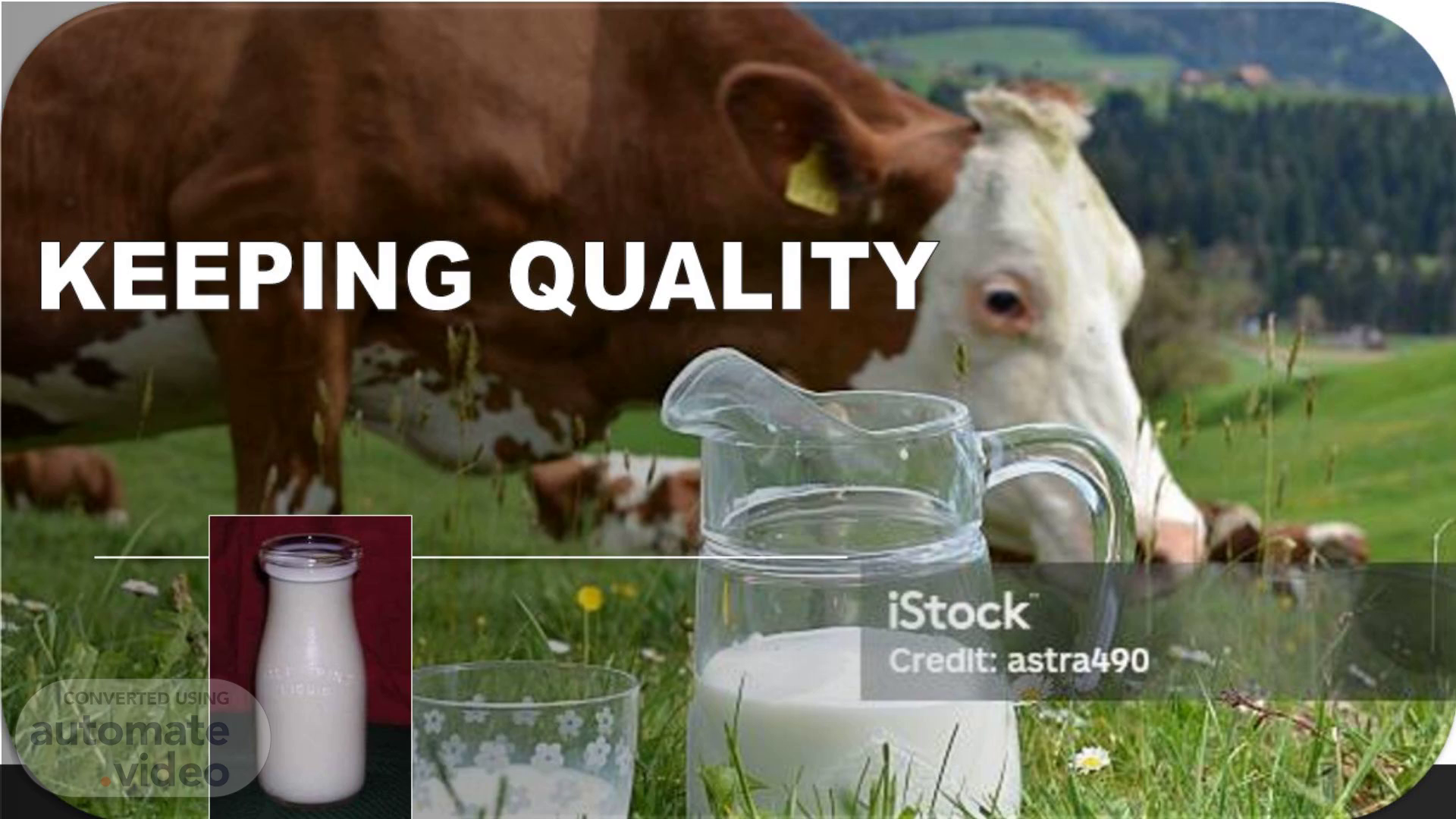Scene 1 (0s)
[image] '5 _iStock Credit: astra490.
Scene 2 (6s)
[Audio] Definition: It is the time in hours elapsed from milk production until it is become unfit for human consumption either: It is clot on boiling or development of unpleasant flavour when stored at 15.5 degrees celsius, 18 degrees celsius or 22 degrees celsius. Sanitary and keeping quality tests Tests depend on acidity. Tests depend on enzymes. Tests depend on sediment and. 10/4/2023 dr. Ibrahim Hassan Amer Bacteriological examination of milk..
Scene 3 (40s)
[Audio] a Tests depend on acidity: 1-Clot on boiling test: (C O B ) 5 ml of milk are put in test tube which is boiled in water bath for 5 minutes. Result and judgement: When the milk becomes a mass of solid material or appearance of very fine particles on the sides of the tube considered: positive. 10/4/2023 dr. Ibrahim Hassan Amer.
Scene 4 (1m 4s)
[Audio] The average acidity at which milk clots on boiling is: 0.23% lactic acid or more. The milk may be clot on boiling in case of: Colostrum. Late stage of lactation. Mastitis due to: disturbance in Ca and P balance. Feeding animal on bone meal..
Scene 5 (1m 23s)
[Audio] b Alcohol precipitation test: (A P T ) One ml of 68% neutral ethyl alcohol is added to: equal amount of milk in a sterile test tube. shake well. Result and judgment: Appearance of slight ppt. adheres to the wall of the test tube or a clot after good mixing indicates: dr. Ibrahim Hassan Amera positive resu1l5t9. 10/4/2023.
Scene 6 (1m 49s)
The test may give positive result in case of: Colostrum. Mastitis. Sweet curdling. The A.P.T gives positive result when the acidity % is: 0.21% lactic acid or more. So the A.P.T is more sensitive than C.O.B test..
Scene 7 (2m 12s)
[Audio] Significance of C O B and A P T: Positive C O B test: The milk is unfit for heat treatment. Positive A P T and negative C O B: The milk must be rapid heat treated..
Scene 8 (2m 29s)
[Audio] c Titratable acidity: Standard method. Soxhlet Henkel method. Acidity %: It is the numbers of grams of lactic acid present in 100 ml of milk. Acidity degree: It is the numbers of ml of NaOH N/9 required to neutralize the lactic acid present in 100 ml of milk. N B ** Titration value of milk = natural acidity plus 1d0/4e/20v23eloped acidity. dr. Ibrahim Hassan Amer 162.
Scene 9 (3m 2s)
[Audio] 1-Standard method: Equipment : Procelain dish. Bureltte. Pipette 1 and 10 ml capacity. Stand. Chemicals: NaOH N/9 Ph. Ph. 1% alcoholic solution. C-O-2 free distilled water. 10/4/2023 dr. Ibrahim Hassan Amer.
Scene 10 (3m 23s)
[Audio] Procedure: In a porcelain dish contain 10 ml milk sample add: 1 ml Ph. Ph. 20 ml Co2 free distilled water. good mixing using glass rod. titrate against NaOH N/9 till obtain end point (faint pink colour). record R sing in titratio1n64). (amount of Ndr.aIbrOahimHHasNsan/9Ameur 10/4/2023.
Scene 11 (3m 48s)
[Audio] Acidity % = R/10 Acidity degree = R x 10 Normal acidity % = 0.12% 0.16 with an average 0.14% lactic acid Normal acidity degree = 12 – 16 average 14 dr. Ibrahim Hassan Amer.
Scene 12 (4m 16s)
[Audio] Determination of pH: Colourimeteric method by using: pH paper. Electrometric method by using: pH meter. Normal pH of freshly drawn milk is ranged from 6.35-6.85 average 6.6 (slight acidic). The slight acidity of milk is due to presence of: Phosphate Albumin 10/4/2023 Casein Co2 Citdrr. aIbrtaheim Hassan Amer.
Scene 13 (4m 43s)
[Audio] Higher acidity is due to: Contamination by lactic acid producing m.os. Colostrum Lower acidity is due to: Mastitis. Late stage of lactation due to increase chlorine. Production of alkaline products by certain microorganisms as: -Pseudomonas fluorescens. -Micrococcus ureae. -Ps. Trifolii. -Alcaligens faecalis. -Alcaligendr.eIbrsahimvHiassscanoAmlaer ctis. 10/4/2023.
Scene 14 (5m 9s)
[Audio] b Tests depend on enzymes: 1-Reductase enzyme: Reductase enzyme is produced only by: m.os. The higher reductase enzyme, the higher bacterial count. The enzyme is able to pick up the O2 from the compounds in which is present loosely such as: methylene blue, resazurin and nitrate 10/4/2023 dr. Ibrahim Hassan Amer.
Scene 15 (5m 35s)
[Audio] Methylene blue reduction test: Resazurin reduction test: Nitrate reduction test:.
Scene 16 (5m 43s)
[Audio] 1-Methylene blue reduction test: In sterile cotton plugged test tube contain 10 ml milk sample. Aseptically add 0.5 ml standardized sterile methylene blue solution followed by incubation in water bath at 37 degrees celsius till complete decolourization and record the time of decolourization. N B Record the results firstly after 20 minutes then every ½ hours..
Scene 17 (6m 11s)
[Audio] Result and judgement: Grades of milk Reduction time Approximal No. of bacteria / ml of milk Good 5.5 hrs or more Less than 500000 Fair 2 – 5.5 hrs 500000 – 4 millions Bad 20 minutes. – 2 hrs 4 – 20 millions Very bad Less than 20 minutes. More than 20 millions.
Scene 18 (6m 35s)
[Audio] 2-Resazurin reduction test: In a sterile cotton plugged test tube contains 10 ml of milk sample, aseptically add 1 ml sterile 0.5% resazurin sol. Followed by incubation in water bath at 37 degrees celsius for 1 hour and record the resulted colour..
Scene 19 (6m 54s)
[Audio] Result and judgment: Grades of milk Colour Excellent Blue Very good Lilac (slight blue) Good Blue violet Fair Red violet Bad Red Very bad Complete decolourization.
Scene 20 (7m 8s)
[Audio] 3-Nitrate reduction test: Add aseptically 1 ml 0.3% sterile pot nitrate solution to sterile cotton plugged test tube contains 10 ml milk sample followed by incubation at 30±1 degrees celsius for 4 hours. Then add 0.25 ml Gries Ilswag reagent (to detect nitrite)..
Scene 21 (7m 33s)
[Audio] Result and judgment: Colour Grades of milk No colour Good Pink Fair Dark pink or red Bad.
